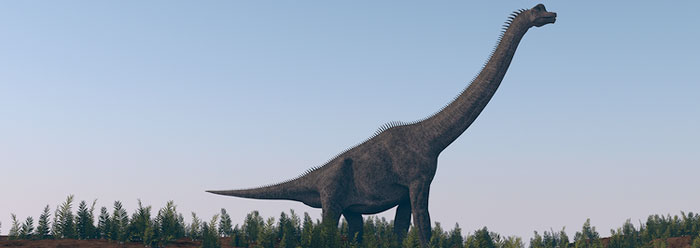The recent Alaskan discovery of an unusual assemblage of footprints in Cretaceous rocks has paleontologists scratching their heads.
Anthony Fiorillo, of the Perot Museum of Nature and Science and his co-authors, reported the trackway discovery in Scientific Reports.1 The numerous footprints were found in Denali National Park in central Alaska in the Cretaceous Lower Cantwell Formation.
The Cantwell Formation is a 13,000-foot-thick succession of conglomerates, sandstones, and shales (with occasional coal seams) containing a diverse collection of fossil flora (plants).1
What made this discovery unusual was the co-occurrence of footprints from two completely different types of dinosaurs: Hadrosaurs (duck-bills) and therizinosaurs—odd-looking bipedal dinosaurs with long necks and long arms and long claws. Fiorillo stated,
Hadrosaurs are very common and found all over Denali National Park. Previously, they had not been found alongside therizinosaurs in the park. From our research, we’ve determined that this track association is currently the only one of its kind in North America.2
The authors of the study did acknowledge that there have been discoveries of hadrosaur and therizinosaur bones in the same rock unit in China, but no co-occurrence of their footprints.2
The paper explained, “It is particularly intriguing given that the hadrosaurs likely had a complex social dynamic, thereby prompting hypotheses of scenarios to explain this rare co-occurrence of taxa.”
The authors conclude that Alaska must have been the “gateway for dinosaurs,” allowing their passage back and forth from Asia to North America.2
The global Flood offers a better explanation for these footprint assemblages. ![]()
Another perplexing footprint discovery was made earlier this year from Cretaceous rocks in Maryland by Ray Stanford and his team.4 At a site on NASA’s Goddard Space Flight Center, over 70 tracks were found in an area of approximately twenty square feet.2 The tracks include small mammal prints, bird-sized theropod dinosaur tracks, pterosaur tracks, large sauropod tracks, and nodosaur dinosaur prints.4
This rare collection of animals, particularly the discovery of the mammal prints, all in a very small area was largely unexpected. The authors claim that this assemblage represents a “near-optimal” condition requiring “special preservational and taphonomic conditions.”4
So, we have two unusual assemblages of diverse fossil footprints showing animals of many different species in close proximity to one another. Secular scientists are scrambling to explain exactly why. Their best explanations seem to involve special conditions and/or congregations along a dinosaur superhighway.
The global Flood offers a better explanation for these footprint assemblages. As the Floodwaters rose higher and higher, animals climbed and scurried to the last remaining portions of land not yet submerged. Some of these locations include what is now Alaska and Maryland. Other locations were in the American West.
I previously explained the discovery of so many dinosaur fossils in the same locations in the American West by identifying a narrow strip of pre-Flood high ground I called the Dinosaur Peninsula, writing, “It seems the dinosaurs were able to survive through the early Flood in the West simply because they were able to congregate and scramble to the elevated remnants of land—places where the related sedimentary deposits aren’t as deep—as the floodwaters advanced.”5
The special preservation of the footprints is easily explained by their rapid burial in the Flood. ![]()
These two recent discoveries of fossil footprints are unusual because they placed diverse fauna (animals) so close together within a short time window. But, these diverse trackways are also expected when viewed as the consequence of a one-time global event. The special preservation of the footprints is easily explained by their rapid burial in the Flood.
References
1. Fiorillo, A. R. et al. 2018. An unusual association of hadrosaur and therizinosaur tracks within Late Cretaceous rocks of Denali National Park, Alaska. Scientific Reports. 8:11706. DOI:10.1038/s41598-018-30110-8
2. News Staff. 2018. Cretaceous Alaska Was ‘Superhighway’ for Migrating Dinosaurs, Paleontologists Say. SciNews. Posted on sci-news.com Aug. 8, 2018, accessed August 22, 2018.
3. Fiorillo, p. 8.
4. Stanford, R. et al. 2018. A diverse mammal-dominated, footprint assemblage from wetland deposits in the Lower Cretaceous of Maryland. Scientific Reports. 8: 741. DOI:10.1038/s41598-017-18619-w
5. Clarey, T. 2015. Dinosaurs found in late Flood rocks. Acts & Facts. 44 (2): 16.
Image: Life reconstruction of hadrosaur-therizinosaur co-occurence based on tracks described in the Fiorillo study.
Image credit: Copyright © Karen Carr. 2018. Used in accordance with federal copyright (fair use doctrine) law. Usage by ICR does not imply endorsement of copyright holder.
*Dr. Timothy Clarey is Research Associate at ICR and earned a doctorate in geology from Western Michigan University.












